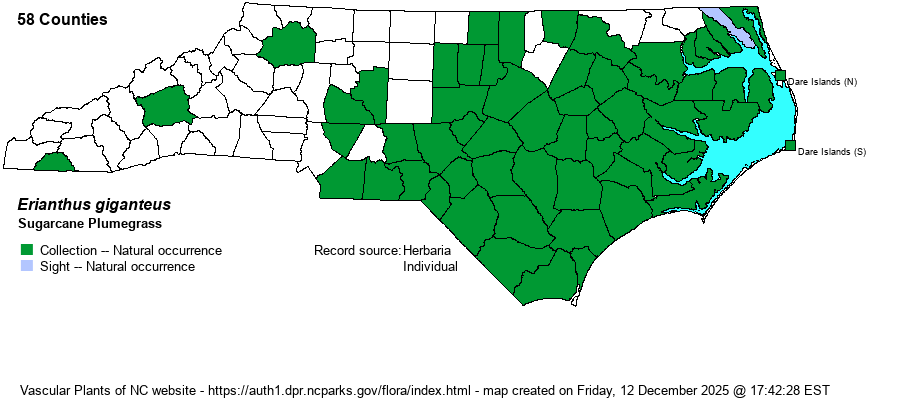| Section 5 » Family Poaceae |
Show/Hide Synonym
| taxonName | relationship | relatedTaxonName | relatedTaxonRefText | relComments |
|---|
|
|
|
|
|
|
| Erianthus giganteus | > | Erianthus giganteus var. giganteus | Fernald (1950) | | | Erianthus giganteus | > | Erianthus giganteus var. compactus | Fernald (1950) | | | Erianthus giganteus | = | Saccharum giganteum | Flora of North America (1993b, 1997, 2000, 2002a, 2002b, 2003a, 2004b, 2005, 2006a, 2006b, 2006c, 2007a, 2009, 2010) | | | Erianthus giganteus | = | Saccharum giganteum | | | | Erianthus giganteus | = | Saccharum giganteum | | | | Erianthus giganteus | = | Saccharum giganteum | | | | Erianthus giganteus | = | Saccharum giganteum | Flora of Virginia | | | Erianthus giganteus | = | Saccharum giganteum | Wunderlin & Hansen Flora of Florida (3) | | | Erianthus giganteus | = | Saccharum giganteum | Hodkinson et al. (2002). [also see Tripidium] | | | Erianthus giganteus | = | Erianthus saccharoides | Small (1933, 1938) | | | Source: Weakley's Flora |
|
| Author | (Walter) Beauvois | |
| Distribution | Coastal Plain, Sandhills, and lower Piedmont; a few scattered records westward. The Buncombe County specimen (DUKE) needs an identification check.
NY to VA, KY, and OK, south to FL and TX; Mex., C.A. | |
| Abundance | Common, except rare in the western 60% of the Piedmont and Mountains. This is clearly an S5 species owing to its abundance in the eastern half of the state. | |
| Habitat | Wet soils of freshwater marshes, fresh-tidal marshes, brackish marshes, interdune marshes and ponds, peat-based pocosins, blackwater streamheads and ecotones, cypress-gum swamp openings, beaver ponds, and other wetlands. |
| Phenology | Flowering and fruiting late August-October. | |
| Identification | This is a very handsome species, as it is our tallest plumegrass (to 8 or 9 feet high) and has the longest and broadest plume - at maturity. When immature, it cannot be safely identified except by technical characters. It also differs from other plumegrasses by its wetland habitats. It might be mistaken for Phragmites, but the plume is relatively compact and lacks long-arching branches. | |
| Taxonomic Comments | Note that FNA and some other texts place plumegrasses in the genus Saccharum -- in this species thus named as S. giganteum. They are certainly closely similar, but the most recent molecular phylogeny splits them.
Plumegrasses are among our tallest grasses; several species reach 7-8 feet tall. The narrowly to broadly elliptical inflorescences stand erect well beyond the long, arching leaves. For proper ID, it is best to use mature spikelets. When immature, the inflorescences are tightly compact and slender; when mature, they relax and become elliptical in outline, and individual spikelets can be seen. Do not confuse these natives with the alien invasive Phragmites australis, which has much broader leaves and whose inflorescence branches are mostly swept to one side. | |
| Other Common Name(s) | Giant Plumegrass is also often used, but more references use Sugarcane Plumegrass as its common name | |
| State Rank | S4 [S5] | |
| Global Rank | G5 | |
| State Status | | |
| US Status | | |
| USACE-agcp | | |
| USACE-emp | | |

